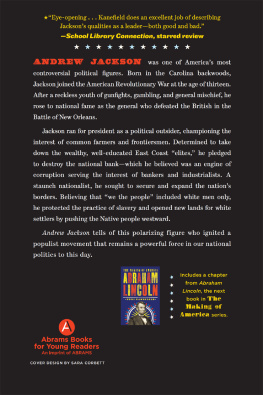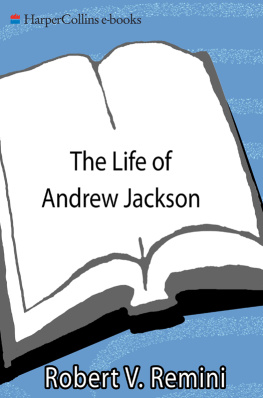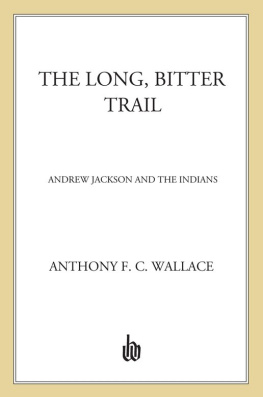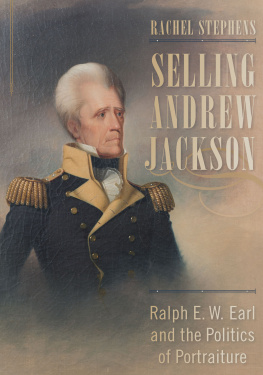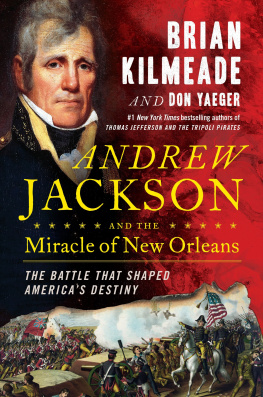ANDREW JACKSON
VOLUME THREE
THE COURSE OF AMERICAN
DEMOCRACY, 18331845
ANDREW JACKSON
VOLUME THREE
THE COURSE OF AMERICAN
DEMOCRACY, 18331845
Robert V. Remini

For my granddaughter,
Caitlin Maureen Costello
All rights to the material from the Livingston Papers quoted in this book are reserved by the John R. Delafield Foundation. No part of this material may be used or reproduced in any manner without written permission from the Foundation.
Copyright 1984 by Robert V. Remini
All rights reserved
Printed in the United States of America on acid-free paper
Originally published in 1984 as Andrew Jackson and the Course of American Democracy,
18331845, by Harper & Row, Publishers, Inc.
Johns Hopkins Paperbacks edition, 1998
9 8 7 6 5 4 3 2 1
The Johns Hopkins University Press
2715 North Charles Street
Baltimore, Maryland 21218-4363
The Johns Hopkins Press Ltd., London
Library of Congress Catalog Card Number 97-75802
A catalog record for this book is available from the British Library.
ISBN 0-8018-5913-1 (pbk.)
When I review the arduous administration thro which I have passed, the formidable opposition I have met to its very close, by the combined talents, wealth, and power of the whole aristocracy of the Union, aided as they were, by the money monopoly, U.S. Bank, with its power of corruption, with which we had to contend, the result must be not only pleasing to me, but to every patriot. It shews the virtue and power of the sovereign people, and that all must bow to public opinion. It was the sovereign people that nobly sustained me against this formidable power, and enabled me to terminate my administration so satisfactory to the great body of the democracy of our Country.
Andrew Jackson to Martin Van Buren
March 30, 1837
Contents
MAPS AND FLOOR PLANS
Acknowledgments
IN WRITING THIS BIOGRAPHY of Andrew Jackson I have been extraordinarily fortunate in having at my disposal the immense resources of the Jackson Papers Project at the Hermitage, Tennessee. This project, conceived by Harriet Chappel Owsley, and handsomely supported by the Ladies Hermitage Association, the Tennessee Historical Commission, and the National Historical Publications Commission, has assembled copies of the vast corpus of Jackson documents located in all parts of the United States and in many foreign countries. I must once again acknowledge my profound debt to the three successive directors of the project: Harriet C. Owsley, Sam B. Smith, and Harold Moser. They not only provided access to this rich collection but actively and personally assisted my research and writing of Jacksons life. And I can never begin to thank the Ladies Hermitage Association for their encouragement and support. It never wavered even when sorely tried by my discussion of Jacksons marriage in volume one. Two members of this association deserve a special salute. Mrs. Fred Russell, regent of the association at the time the project was first proposed, lent her considerable influence in winning approval for the idea of collecting Jackson documents at the Hermitage. Without her active interest in the value and worth of the project it would have been impossible to achieve the necessary degree of support for this undertaking, since no university or research library seemed capable or willing to commit themselves to it at that time. Mrs. Harry A. J. Joyce, research coordinator of the association and member of the board of directors, seconded Mrs. Russells efforts and provided essential aid at several critical moments. Both women have earned the lasting gratitude of Jackson scholars everywhere.
In preparing this final volume of the biography I was also fortunate to have at my disposal the splendid collection of Edward Livingston Papers maintained by the John R. Delafield Foundation. These papers have enriched my reading of the French spoliation controversy, among other things, and for permission to use this material I am profoundly grateful to John W. Delafield, Esq.
Essential to the final preparation of this biography have been the comments and criticisms from friends and colleagues in the profession who read all or parts of the manuscript and suggested needed changes or pointed out obvious and sometimes less than obvious mistakes. My colleague at the University of Illinois Peter J. Coleman read the entire manuscript in one of its earliest versions and gave me the benefit of his editorial skills and vast knowledge of American history. My friend John Niven of the Claremont Graduate School also read the entire manuscript in a later revision and provided me with telling criticism. Having just published a biography of Martin Van Buren, Professor Niven was particularly well qualified to catch all those small details that sometime threaten to slide into error. I am very grateful to him. As she did in volumes one and two of the biography, Harriet C. Owsley read selected chapters that touched on her expertise in Tennessee history and the Jackson family history. She has been my friend and staunch supporter since 1960, when I first walked into her office at the Tennessee State Library and Archives and asked to see all the Jackson manuscripts held by the library. There is no way I can properly thank her for all her many kindnesses over the past twenty and more years. Professor Mary Young of the University of Rochester read the chapter on Indian removal and wrote several pages of criticisms and suggestions. She alerted me to so many misstatements and foolish comments that she deserves most of the credit for whatever sophisticated parts can be found in that chapter. I only hope this acknowledgment does not jeopardize her good standing with her Native American friends and their allies.
Again, I wish to thank my friend John McDonough, manuscript historian of the Library of Congress, for his never ending help. He has watched over the progress of this biography since its inception and has gone out of his way to inform me of all new acquisitions of Jackson material both at the Library of Congress and at other repositories around the country. John H. Thweatt, senior archivist of the Tennessee State Library and Archives, has also provided every conceivable assistance in advancing this biography to its conclusion. My friends Wayne Cutler and Carese Parker, editor and associate editor of the James K. Polk Papers at Vanderbilt University, not only assisted me with information about relevant documentary materials but shared with me their considerable knowledge of national and Tennessee politics throughout the Jacksonian era.
Dr. William Seale provided the drawings of the White House rooms, which I revised very slightly in accordance with the findings of my own research. I am extremely grateful to him for his enormous help, and elsewhere in this book I have acknowledged my debt about details of White House activities during Jacksons administration. Annette Melville, art librarian at the Library of Congress, guided me in all three volumes of the biography in the selection of appropriate pictures and dust-jacket portraits of Jackson. Mrs. Allan Steele, chairman of the Museum and Relics Committee of the Ladies Hermitage Association, made available copies of many pictures belonging to the association. And Betty C. Monkman, associate curator of the White House, not only allowed me to examine surviving pieces of service wear in the executive mansion from Jacksons administration but also provided copies of several pictures of Old Hickory in the possession of the White House.
Next page

